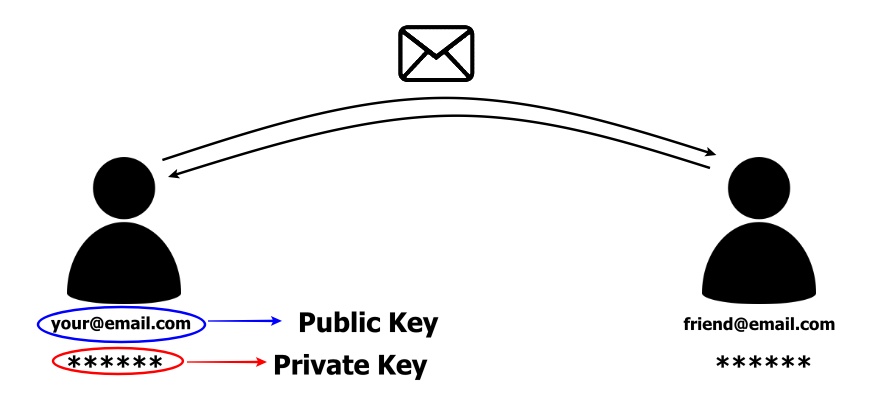Differences Between Private Key and Public Key In a Crypto Blockchain
If you’re in cryptocurrency jargon for a while, then you have heard the term “Public Key”, “Private Key” many times.
If you’re confused and don’t know anything about Private and Public Keys, then this is the post you should read.
In this post, I’ll simply explain what public, private keys are and how they differ from each other.
But before jumping on the main post, you must know some of these terms.
Hashing:
Hashing is the method of cryptography that converts any form of data (no matter its size or type) into a unique fixed-length string of text.
Symmetric Key Cryptography:
This is a type of cryptography where both the sender and receiver use a single key, meaning a Private Key during the communication or transfer of information.
Asymmetric Key Cryptography:
This is another type of cryptography. Here two keys are used by sender and receiver during the communication or transfer of information.
In cryptocurrencies, Asymmetric Key Cryptography is widely used by creating Private and Public Keys to store, send and receive funds.
What Is a Private Key?
Private Key AKA Secret Key is a long string created by the complex mathematical algorithm within cryptography that enables users to access their cryptocurrency.
Simply put, a private key is a long string that is limited to certain characters created by a cryptography algorithm to enable you to access your funds.
A private key is the heart and soul of cryptocurrency because it verifies that you’re the real owner of the funds. So if you lose the private key, you lose funds.
How Is a Private Key Created?
As I mentioned, a private key is created by the cryptography algorithm. To be precise, in Bitcoin this cryptographic algorithm is called ECDSA (Elliptic Curve Digital Signature Algorithm), which uses 256-bit encryption to create a private key.
In the real world, you don’t have to create a private key yourself because all of the online wallets like exchanges do it for you, so they have control over your private key, but in hardware or non-custodial wallets, you create a private key using a 12-word mnemonic phrase.
If you want to create a private key on your own, do check out this post describing how to create a Bitcoin private key.
What Is a Public Key?
Public Key is derived from Private Key.
So, without the Private Key, you don’t have the Public Key. In order to get the Public Key first, you must create a Private Key using a cryptography algorithm then apply rules of generating Public Key from the algorithm to the Private Key.
Contrary to Private Key, you can give Public Key to anyone. It is not a secret. Also, you can lose your Public Key and generate it later from the Private Key, but you can’t generate Private Key with Public Key.
How Is a Public Key Created?
Public Key is created by applying further encryption to Private Key.
For example, in Bitcoin, the Public Key is generated by performing an EC point multiplication with the curve’s base point to the Private Key (to learn more about this encryption jargon, click on this wiki page).
To put simply, you can think of Private Key and Public Keys as email, here Private Key is your email password so only you know the email password for sending emails and open received emails, and the Public Key is your email address which can be known to the general public so they can send you email, but no one has access to your email account unless they have the correct password AKA Private Key.

The one difference is. In Email, there is one Email address attached to one password, but in cryptocurrencies, you create one Public Key from the one Private Key, then further hashing Public Key get an Address to receive funds.
Private Key vs Public Key.
| Private Key. | Public Key. |
|---|---|
| Private Key is created by the cryptocurrency algorithm using a random number. For example, in the Bitcoin case, that random number has to be between 1 and 2256. | Public Key derived from the Private Key. |
| Private Key has to be kept secret and backed up. Because if you lose your Private Key, you lose your funds. | On the other hand, there is no need to worry about keeping a Public Key secret because it is derived from a Private Key and impossible to get a Private Key out of it. |
| Private Key can do both encryption and decryption. | Public Key only used encryption. |
| Private Key ensures you’re the real owner of funds. | Public Key is used to send and receive funds by creating addresses. |
Conclusion.
Now you know what Private and Public Keys are. And how they’re different and their use case in the crypto world.
It is important to know about these keys before entering the crypto world because your crypto fund’s safety depends upon them.
Speaking about safety, today most newbies firstly go to any exchange for creating a wallet to store crypto funds which are considered as not a safe move because crypto exchanges store Private Keys on their servers and are prone to hacking, even most of the biggest crypto hackings are done to exchanges.
Instead of going to crypto exchanges, first, you can easily create a wallet using coin core software or using a non-custodial wallet that does not store Private Key on their servers, or you can use any Hardware Wallet that stores a Private Key on the physical device.
Even if you know cryptography enough, you can create your own Private Key as per the specific coin cryptography algorithm.
Also, there are websites like bitaddress.org letting you create a Private Key just by hovering your mouse and then giving you the option to store those Private Keys differently.
So, ultimately it’s up to you how you want to create your first Private Key.
